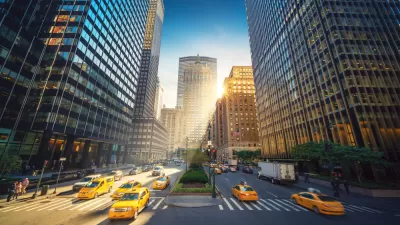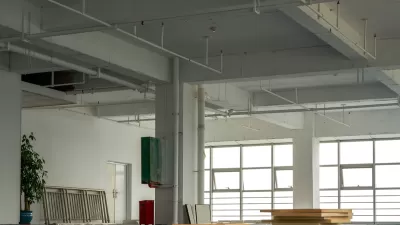The company is moving away from flashy new campuses in favor of converting existing buildings with interesting histories.

For years, tech giants have been building massive, new design-y headquarters, writes Nate Berg in Fast Company. “Increasingly though, Google is going a different route. Instead of solely building modern, amenity-rich campuses, the tech giant is putting more of its now-global real estate dollars into adaptively reusing old, significant, and interesting structures.”
In Los Angeles, an airplane hangar originally built by Howard Hughes for the construction of the Spruce Goose was bought by Google in the 2010s and converted into a 450,000-square-foot office complex. “Another project in Sunnyvale, California, is adapting a more recent piece of historic industrial architecture, turning a 1960s-era research and development facility of one of the first mainframe-computer makers into a 250,000-square-foot office building.”
“All this reuse is an office real estate strategy that makes a lot of sense in the hybrid work era coming out of the pandemic.” As Berg explains, “Bakker says making older buildings more energy efficient plays into Google’s sustainability goals, while also bolstering its environmental, social, and corporate governance (ESG) values. Doing so with very visible buildings and neighborhood projects becomes a form of marketing all on its own.”
FULL STORY: Google’s office strategy used to be new buildings. Now, it’s old warehouses

Alabama: Trump Terminates Settlements for Black Communities Harmed By Raw Sewage
Trump deemed the landmark civil rights agreement “illegal DEI and environmental justice policy.”

Planetizen Federal Action Tracker
A weekly monitor of how Trump’s orders and actions are impacting planners and planning in America.

Why Should We Subsidize Public Transportation?
Many public transit agencies face financial stress due to rising costs, declining fare revenue, and declining subsidies. Transit advocates must provide a strong business case for increasing public transit funding.

Understanding Road Diets
An explainer from Momentum highlights the advantages of reducing vehicle lanes in favor of more bike, transit, and pedestrian infrastructure.

New California Law Regulates Warehouse Pollution
A new law tightens building and emissions regulations for large distribution warehouses to mitigate air pollution and traffic in surrounding communities.

Phoenix Announces Opening Date for Light Rail Extension
The South Central extension will connect South Phoenix to downtown and other major hubs starting on June 7.
Urban Design for Planners 1: Software Tools
This six-course series explores essential urban design concepts using open source software and equips planners with the tools they need to participate fully in the urban design process.
Planning for Universal Design
Learn the tools for implementing Universal Design in planning regulations.
Caltrans
Smith Gee Studio
Institute for Housing and Urban Development Studies (IHS)
City of Grandview
Harvard GSD Executive Education
Toledo-Lucas County Plan Commissions
Salt Lake City
NYU Wagner Graduate School of Public Service





























